Strategic Leadership Practices and Management Report Analysis
VerifiedAdded on 2019/12/17
|15
|4693
|128
Report
AI Summary
This report delves into strategic leadership practices, examining the concepts of managers as effective leaders and leaders as effective managers. It explores the balance needed between strategic management and leadership, analyzing the strategic leader's role in creating a company's vision, mission, and values, with McDonald's as a case study. The report investigates how leaders communicate these elements and how personal energy, self-belief, and commitment influence leadership styles. It also evaluates the impact of ethical leadership on management, along with an in-depth analysis of transformational, transactional, and situational leadership styles and their effects on a company's strategy. The report highlights the importance of managing change and communicating effectively within an organization, providing valuable insights into the complexities of strategic leadership.
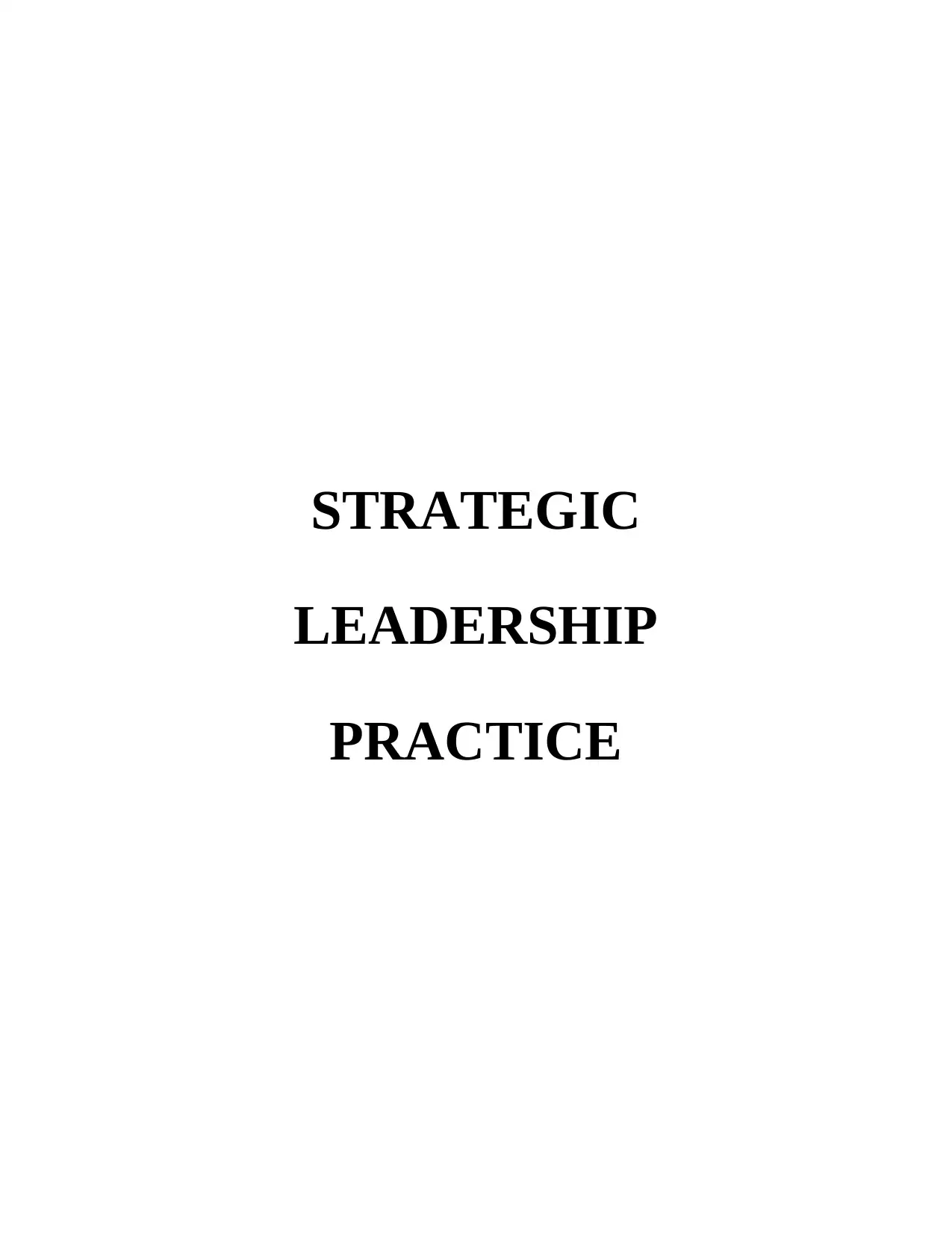
STRATEGIC
LEADERSHIP
PRACTICE
LEADERSHIP
PRACTICE
Paraphrase This Document
Need a fresh take? Get an instant paraphrase of this document with our AI Paraphraser
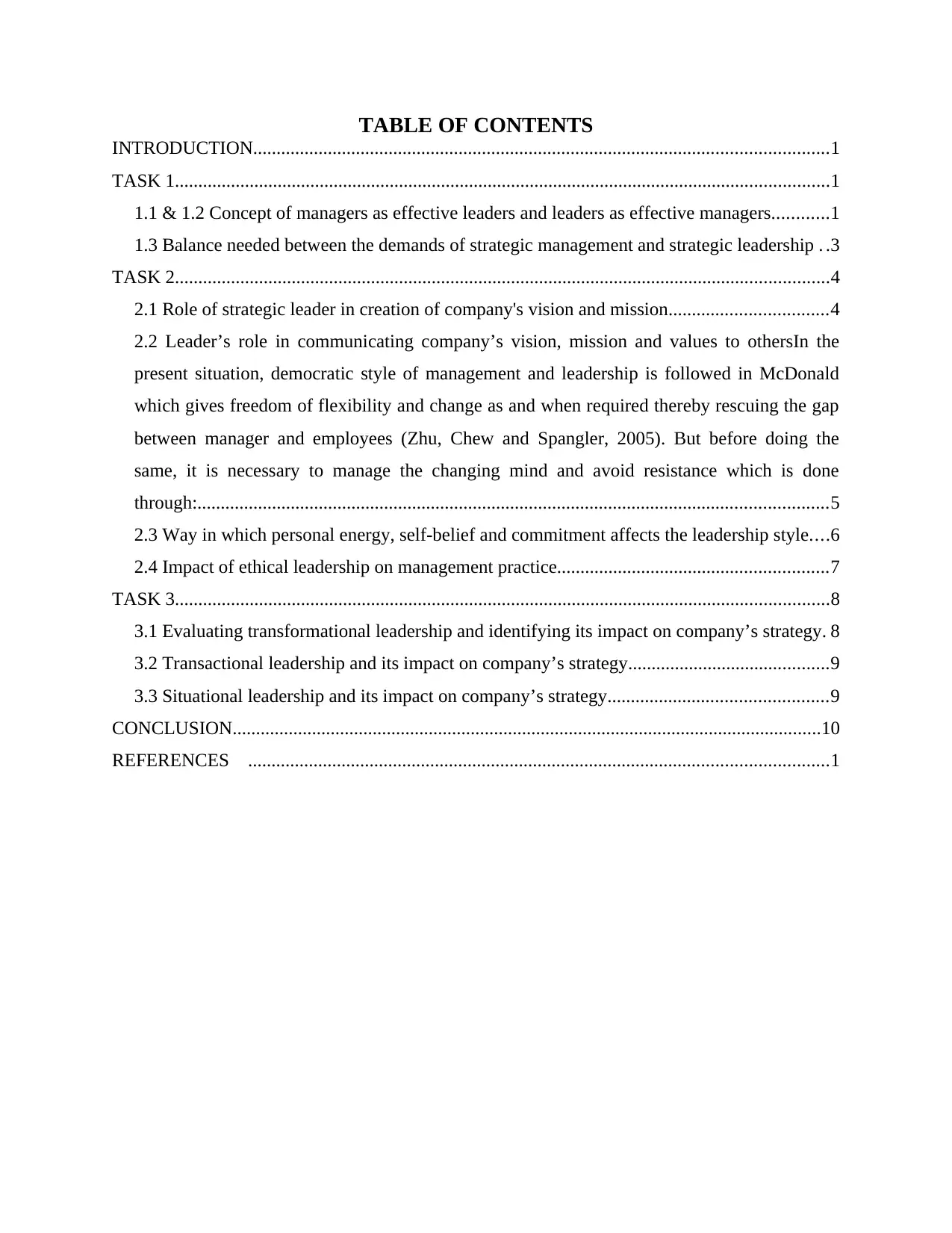
TABLE OF CONTENTS
INTRODUCTION...........................................................................................................................1
TASK 1............................................................................................................................................1
1.1 & 1.2 Concept of managers as effective leaders and leaders as effective managers............1
1.3 Balance needed between the demands of strategic management and strategic leadership . .3
TASK 2............................................................................................................................................4
2.1 Role of strategic leader in creation of company's vision and mission..................................4
2.2 Leader’s role in communicating company’s vision, mission and values to othersIn the
present situation, democratic style of management and leadership is followed in McDonald
which gives freedom of flexibility and change as and when required thereby rescuing the gap
between manager and employees (Zhu, Chew and Spangler, 2005). But before doing the
same, it is necessary to manage the changing mind and avoid resistance which is done
through:.......................................................................................................................................5
2.3 Way in which personal energy, self-belief and commitment affects the leadership style....6
2.4 Impact of ethical leadership on management practice..........................................................7
TASK 3............................................................................................................................................8
3.1 Evaluating transformational leadership and identifying its impact on company’s strategy. 8
3.2 Transactional leadership and its impact on company’s strategy...........................................9
3.3 Situational leadership and its impact on company’s strategy...............................................9
CONCLUSION..............................................................................................................................10
REFERENCES ............................................................................................................................1
INTRODUCTION...........................................................................................................................1
TASK 1............................................................................................................................................1
1.1 & 1.2 Concept of managers as effective leaders and leaders as effective managers............1
1.3 Balance needed between the demands of strategic management and strategic leadership . .3
TASK 2............................................................................................................................................4
2.1 Role of strategic leader in creation of company's vision and mission..................................4
2.2 Leader’s role in communicating company’s vision, mission and values to othersIn the
present situation, democratic style of management and leadership is followed in McDonald
which gives freedom of flexibility and change as and when required thereby rescuing the gap
between manager and employees (Zhu, Chew and Spangler, 2005). But before doing the
same, it is necessary to manage the changing mind and avoid resistance which is done
through:.......................................................................................................................................5
2.3 Way in which personal energy, self-belief and commitment affects the leadership style....6
2.4 Impact of ethical leadership on management practice..........................................................7
TASK 3............................................................................................................................................8
3.1 Evaluating transformational leadership and identifying its impact on company’s strategy. 8
3.2 Transactional leadership and its impact on company’s strategy...........................................9
3.3 Situational leadership and its impact on company’s strategy...............................................9
CONCLUSION..............................................................................................................................10
REFERENCES ............................................................................................................................1

INTRODUCTION
In order to operate the organization in an effective and efficient manner, leading the
organization with efficient leadership qualities is very important as a leader sets out the outline
of doing work in line with organization’s objectives and goals as well as make sure that it is
communicated to the subordinates in the same manner without any ambiguity. In order to run an
organization successfully, it is necessary to run it with effective management and leadership
skills. This can help to manage changes and run the organization effectually. Following report
will be explaining the necessary points related with leadership and strategies enabling leadership
(Jansen, Vera and Crossan, 2009). Main aim of the project is to carry out a better understanding
and knowledge about different aspects of leaderships and their strategies. Moreover, the role of
the strategic leader in determining mission, vision and setting objectives of business will be
analysed. The study will also evaluate the way in which these aspects are communicated to the
market and consumers. Further the impacts of ethical leadership on managerial activities will be
analysed in the study.
TASK 1
1.1 & 1.2 Concept of managers as effective leaders and leaders as effective managers
Leaders and managers are the terms which are often used interchangeably and go hand in
hand while managing an organization. In some organizations, leaders and managers are the same
people because of inherent qualities of leadership in some managers while some leaders can be a
person who belongs to the group and does not have any assigned management duties (Jackson
and Parry, 2011). For the same, it is important to understand the definition of leadership and
management and the difference between two is shown as below:
Leadership is defined as the quality followed by the leaders in the form of giving them
new vision and direction to do a particular task. While managers makes it ensure through his
management that the task is within the boundaries of well established principles of the
organization .
A manager administrates the work done by people under him while a leader motivates not
only the people under him but all over the organization (Montabon, Sroufe and Narasimhan,
2007).
In order to operate the organization in an effective and efficient manner, leading the
organization with efficient leadership qualities is very important as a leader sets out the outline
of doing work in line with organization’s objectives and goals as well as make sure that it is
communicated to the subordinates in the same manner without any ambiguity. In order to run an
organization successfully, it is necessary to run it with effective management and leadership
skills. This can help to manage changes and run the organization effectually. Following report
will be explaining the necessary points related with leadership and strategies enabling leadership
(Jansen, Vera and Crossan, 2009). Main aim of the project is to carry out a better understanding
and knowledge about different aspects of leaderships and their strategies. Moreover, the role of
the strategic leader in determining mission, vision and setting objectives of business will be
analysed. The study will also evaluate the way in which these aspects are communicated to the
market and consumers. Further the impacts of ethical leadership on managerial activities will be
analysed in the study.
TASK 1
1.1 & 1.2 Concept of managers as effective leaders and leaders as effective managers
Leaders and managers are the terms which are often used interchangeably and go hand in
hand while managing an organization. In some organizations, leaders and managers are the same
people because of inherent qualities of leadership in some managers while some leaders can be a
person who belongs to the group and does not have any assigned management duties (Jackson
and Parry, 2011). For the same, it is important to understand the definition of leadership and
management and the difference between two is shown as below:
Leadership is defined as the quality followed by the leaders in the form of giving them
new vision and direction to do a particular task. While managers makes it ensure through his
management that the task is within the boundaries of well established principles of the
organization .
A manager administrates the work done by people under him while a leader motivates not
only the people under him but all over the organization (Montabon, Sroufe and Narasimhan,
2007).
⊘ This is a preview!⊘
Do you want full access?
Subscribe today to unlock all pages.

Trusted by 1+ million students worldwide
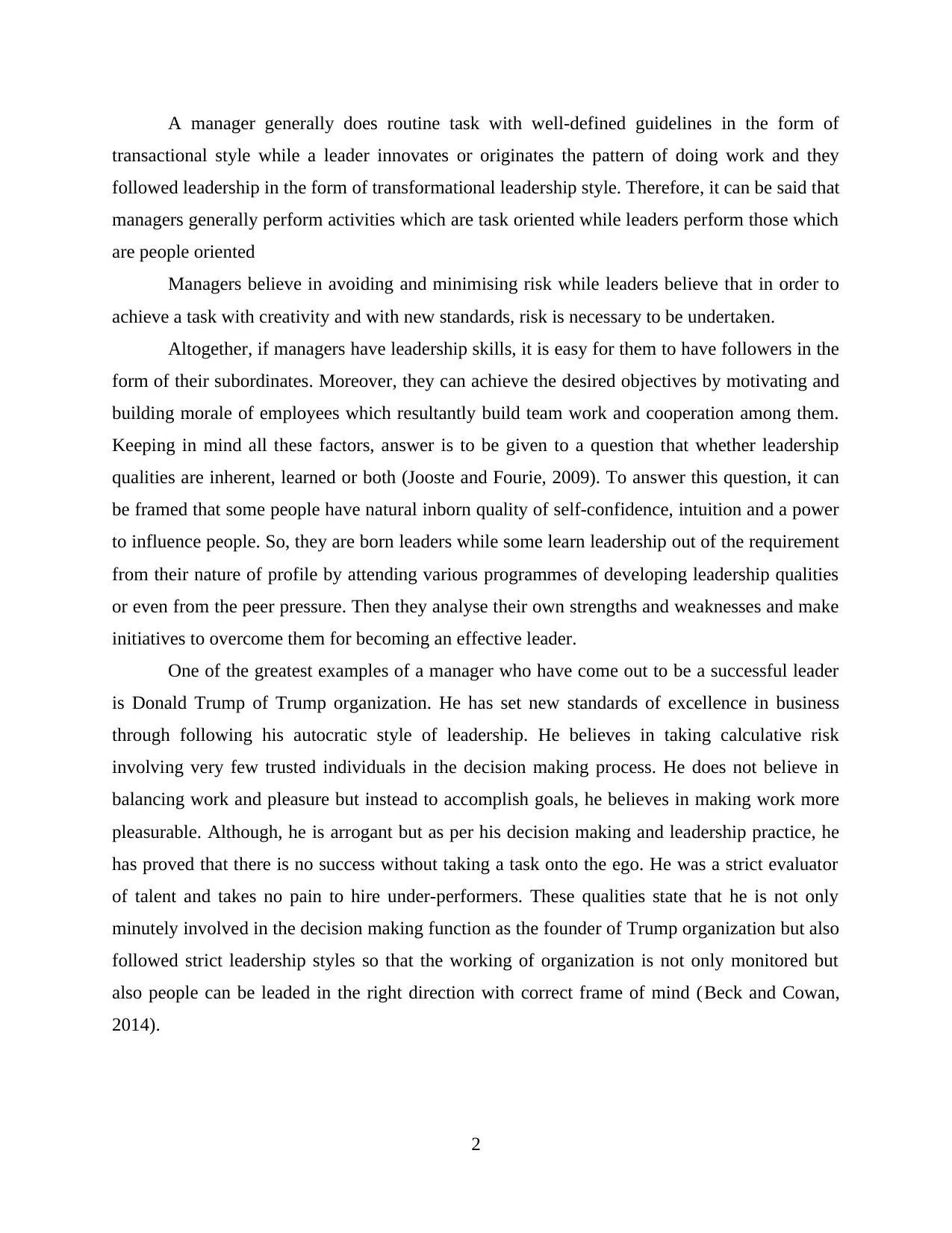
A manager generally does routine task with well-defined guidelines in the form of
transactional style while a leader innovates or originates the pattern of doing work and they
followed leadership in the form of transformational leadership style. Therefore, it can be said that
managers generally perform activities which are task oriented while leaders perform those which
are people oriented
Managers believe in avoiding and minimising risk while leaders believe that in order to
achieve a task with creativity and with new standards, risk is necessary to be undertaken.
Altogether, if managers have leadership skills, it is easy for them to have followers in the
form of their subordinates. Moreover, they can achieve the desired objectives by motivating and
building morale of employees which resultantly build team work and cooperation among them.
Keeping in mind all these factors, answer is to be given to a question that whether leadership
qualities are inherent, learned or both (Jooste and Fourie, 2009). To answer this question, it can
be framed that some people have natural inborn quality of self-confidence, intuition and a power
to influence people. So, they are born leaders while some learn leadership out of the requirement
from their nature of profile by attending various programmes of developing leadership qualities
or even from the peer pressure. Then they analyse their own strengths and weaknesses and make
initiatives to overcome them for becoming an effective leader.
One of the greatest examples of a manager who have come out to be a successful leader
is Donald Trump of Trump organization. He has set new standards of excellence in business
through following his autocratic style of leadership. He believes in taking calculative risk
involving very few trusted individuals in the decision making process. He does not believe in
balancing work and pleasure but instead to accomplish goals, he believes in making work more
pleasurable. Although, he is arrogant but as per his decision making and leadership practice, he
has proved that there is no success without taking a task onto the ego. He was a strict evaluator
of talent and takes no pain to hire under-performers. These qualities state that he is not only
minutely involved in the decision making function as the founder of Trump organization but also
followed strict leadership styles so that the working of organization is not only monitored but
also people can be leaded in the right direction with correct frame of mind (Beck and Cowan,
2014).
2
transactional style while a leader innovates or originates the pattern of doing work and they
followed leadership in the form of transformational leadership style. Therefore, it can be said that
managers generally perform activities which are task oriented while leaders perform those which
are people oriented
Managers believe in avoiding and minimising risk while leaders believe that in order to
achieve a task with creativity and with new standards, risk is necessary to be undertaken.
Altogether, if managers have leadership skills, it is easy for them to have followers in the
form of their subordinates. Moreover, they can achieve the desired objectives by motivating and
building morale of employees which resultantly build team work and cooperation among them.
Keeping in mind all these factors, answer is to be given to a question that whether leadership
qualities are inherent, learned or both (Jooste and Fourie, 2009). To answer this question, it can
be framed that some people have natural inborn quality of self-confidence, intuition and a power
to influence people. So, they are born leaders while some learn leadership out of the requirement
from their nature of profile by attending various programmes of developing leadership qualities
or even from the peer pressure. Then they analyse their own strengths and weaknesses and make
initiatives to overcome them for becoming an effective leader.
One of the greatest examples of a manager who have come out to be a successful leader
is Donald Trump of Trump organization. He has set new standards of excellence in business
through following his autocratic style of leadership. He believes in taking calculative risk
involving very few trusted individuals in the decision making process. He does not believe in
balancing work and pleasure but instead to accomplish goals, he believes in making work more
pleasurable. Although, he is arrogant but as per his decision making and leadership practice, he
has proved that there is no success without taking a task onto the ego. He was a strict evaluator
of talent and takes no pain to hire under-performers. These qualities state that he is not only
minutely involved in the decision making function as the founder of Trump organization but also
followed strict leadership styles so that the working of organization is not only monitored but
also people can be leaded in the right direction with correct frame of mind (Beck and Cowan,
2014).
2
Paraphrase This Document
Need a fresh take? Get an instant paraphrase of this document with our AI Paraphraser
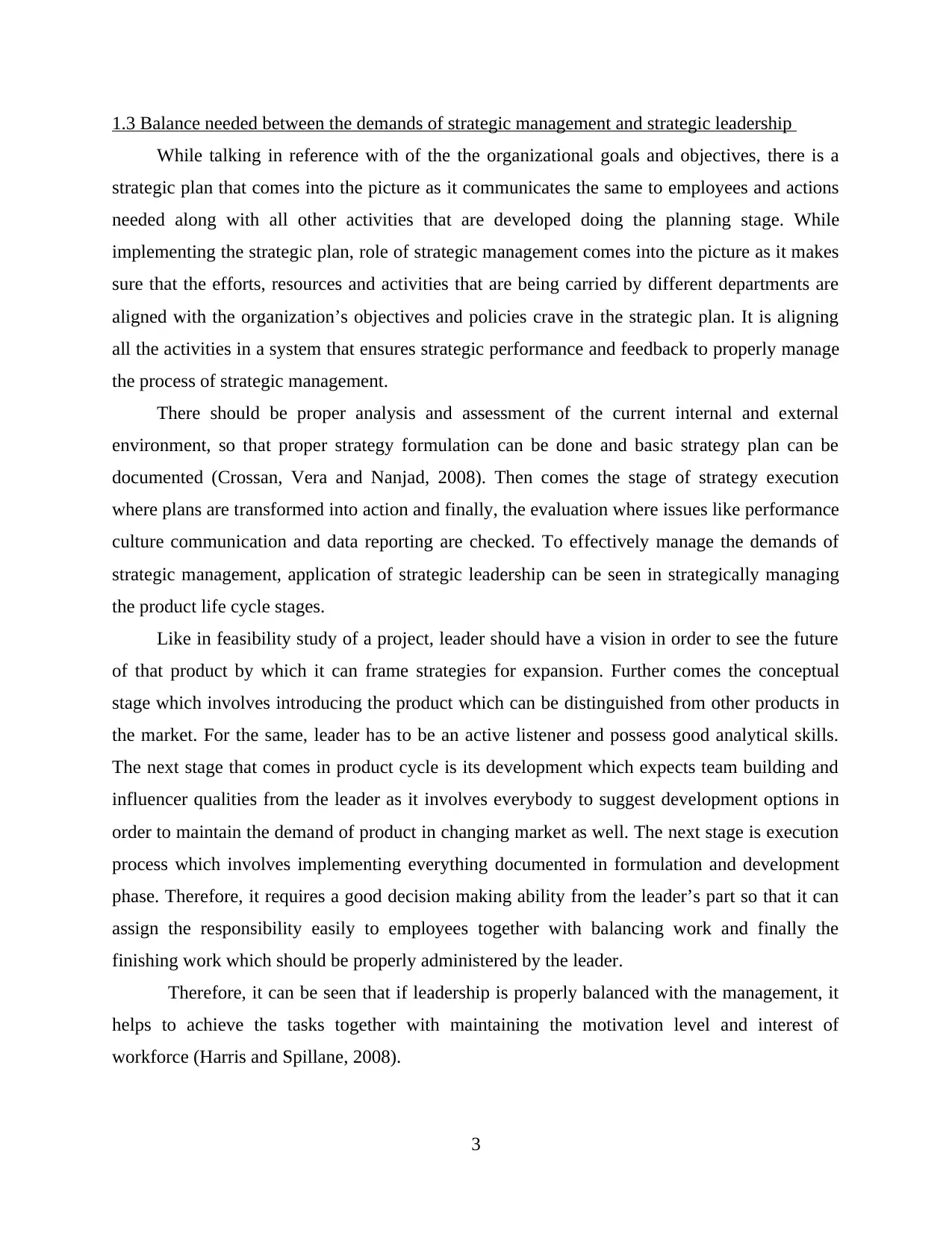
1.3 Balance needed between the demands of strategic management and strategic leadership
While talking in reference with of the the organizational goals and objectives, there is a
strategic plan that comes into the picture as it communicates the same to employees and actions
needed along with all other activities that are developed doing the planning stage. While
implementing the strategic plan, role of strategic management comes into the picture as it makes
sure that the efforts, resources and activities that are being carried by different departments are
aligned with the organization’s objectives and policies crave in the strategic plan. It is aligning
all the activities in a system that ensures strategic performance and feedback to properly manage
the process of strategic management.
There should be proper analysis and assessment of the current internal and external
environment, so that proper strategy formulation can be done and basic strategy plan can be
documented (Crossan, Vera and Nanjad, 2008). Then comes the stage of strategy execution
where plans are transformed into action and finally, the evaluation where issues like performance
culture communication and data reporting are checked. To effectively manage the demands of
strategic management, application of strategic leadership can be seen in strategically managing
the product life cycle stages.
Like in feasibility study of a project, leader should have a vision in order to see the future
of that product by which it can frame strategies for expansion. Further comes the conceptual
stage which involves introducing the product which can be distinguished from other products in
the market. For the same, leader has to be an active listener and possess good analytical skills.
The next stage that comes in product cycle is its development which expects team building and
influencer qualities from the leader as it involves everybody to suggest development options in
order to maintain the demand of product in changing market as well. The next stage is execution
process which involves implementing everything documented in formulation and development
phase. Therefore, it requires a good decision making ability from the leader’s part so that it can
assign the responsibility easily to employees together with balancing work and finally the
finishing work which should be properly administered by the leader.
Therefore, it can be seen that if leadership is properly balanced with the management, it
helps to achieve the tasks together with maintaining the motivation level and interest of
workforce (Harris and Spillane, 2008).
3
While talking in reference with of the the organizational goals and objectives, there is a
strategic plan that comes into the picture as it communicates the same to employees and actions
needed along with all other activities that are developed doing the planning stage. While
implementing the strategic plan, role of strategic management comes into the picture as it makes
sure that the efforts, resources and activities that are being carried by different departments are
aligned with the organization’s objectives and policies crave in the strategic plan. It is aligning
all the activities in a system that ensures strategic performance and feedback to properly manage
the process of strategic management.
There should be proper analysis and assessment of the current internal and external
environment, so that proper strategy formulation can be done and basic strategy plan can be
documented (Crossan, Vera and Nanjad, 2008). Then comes the stage of strategy execution
where plans are transformed into action and finally, the evaluation where issues like performance
culture communication and data reporting are checked. To effectively manage the demands of
strategic management, application of strategic leadership can be seen in strategically managing
the product life cycle stages.
Like in feasibility study of a project, leader should have a vision in order to see the future
of that product by which it can frame strategies for expansion. Further comes the conceptual
stage which involves introducing the product which can be distinguished from other products in
the market. For the same, leader has to be an active listener and possess good analytical skills.
The next stage that comes in product cycle is its development which expects team building and
influencer qualities from the leader as it involves everybody to suggest development options in
order to maintain the demand of product in changing market as well. The next stage is execution
process which involves implementing everything documented in formulation and development
phase. Therefore, it requires a good decision making ability from the leader’s part so that it can
assign the responsibility easily to employees together with balancing work and finally the
finishing work which should be properly administered by the leader.
Therefore, it can be seen that if leadership is properly balanced with the management, it
helps to achieve the tasks together with maintaining the motivation level and interest of
workforce (Harris and Spillane, 2008).
3
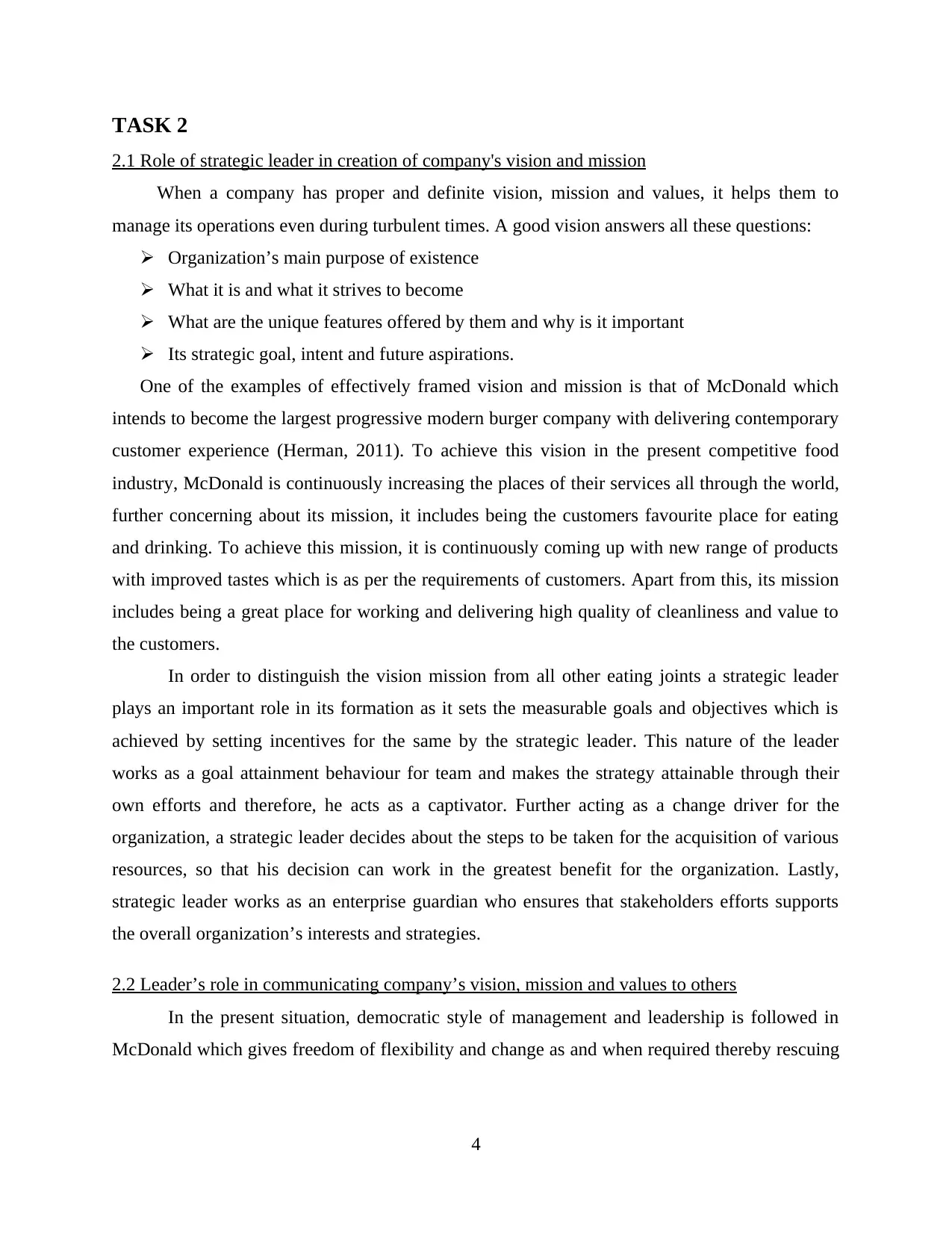
TASK 2
2.1 Role of strategic leader in creation of company's vision and mission
When a company has proper and definite vision, mission and values, it helps them to
manage its operations even during turbulent times. A good vision answers all these questions:
Organization’s main purpose of existence
What it is and what it strives to become
What are the unique features offered by them and why is it important
Its strategic goal, intent and future aspirations.
One of the examples of effectively framed vision and mission is that of McDonald which
intends to become the largest progressive modern burger company with delivering contemporary
customer experience (Herman, 2011). To achieve this vision in the present competitive food
industry, McDonald is continuously increasing the places of their services all through the world,
further concerning about its mission, it includes being the customers favourite place for eating
and drinking. To achieve this mission, it is continuously coming up with new range of products
with improved tastes which is as per the requirements of customers. Apart from this, its mission
includes being a great place for working and delivering high quality of cleanliness and value to
the customers.
In order to distinguish the vision mission from all other eating joints a strategic leader
plays an important role in its formation as it sets the measurable goals and objectives which is
achieved by setting incentives for the same by the strategic leader. This nature of the leader
works as a goal attainment behaviour for team and makes the strategy attainable through their
own efforts and therefore, he acts as a captivator. Further acting as a change driver for the
organization, a strategic leader decides about the steps to be taken for the acquisition of various
resources, so that his decision can work in the greatest benefit for the organization. Lastly,
strategic leader works as an enterprise guardian who ensures that stakeholders efforts supports
the overall organization’s interests and strategies.
2.2 Leader’s role in communicating company’s vision, mission and values to others
In the present situation, democratic style of management and leadership is followed in
McDonald which gives freedom of flexibility and change as and when required thereby rescuing
4
2.1 Role of strategic leader in creation of company's vision and mission
When a company has proper and definite vision, mission and values, it helps them to
manage its operations even during turbulent times. A good vision answers all these questions:
Organization’s main purpose of existence
What it is and what it strives to become
What are the unique features offered by them and why is it important
Its strategic goal, intent and future aspirations.
One of the examples of effectively framed vision and mission is that of McDonald which
intends to become the largest progressive modern burger company with delivering contemporary
customer experience (Herman, 2011). To achieve this vision in the present competitive food
industry, McDonald is continuously increasing the places of their services all through the world,
further concerning about its mission, it includes being the customers favourite place for eating
and drinking. To achieve this mission, it is continuously coming up with new range of products
with improved tastes which is as per the requirements of customers. Apart from this, its mission
includes being a great place for working and delivering high quality of cleanliness and value to
the customers.
In order to distinguish the vision mission from all other eating joints a strategic leader
plays an important role in its formation as it sets the measurable goals and objectives which is
achieved by setting incentives for the same by the strategic leader. This nature of the leader
works as a goal attainment behaviour for team and makes the strategy attainable through their
own efforts and therefore, he acts as a captivator. Further acting as a change driver for the
organization, a strategic leader decides about the steps to be taken for the acquisition of various
resources, so that his decision can work in the greatest benefit for the organization. Lastly,
strategic leader works as an enterprise guardian who ensures that stakeholders efforts supports
the overall organization’s interests and strategies.
2.2 Leader’s role in communicating company’s vision, mission and values to others
In the present situation, democratic style of management and leadership is followed in
McDonald which gives freedom of flexibility and change as and when required thereby rescuing
4
⊘ This is a preview!⊘
Do you want full access?
Subscribe today to unlock all pages.

Trusted by 1+ million students worldwide
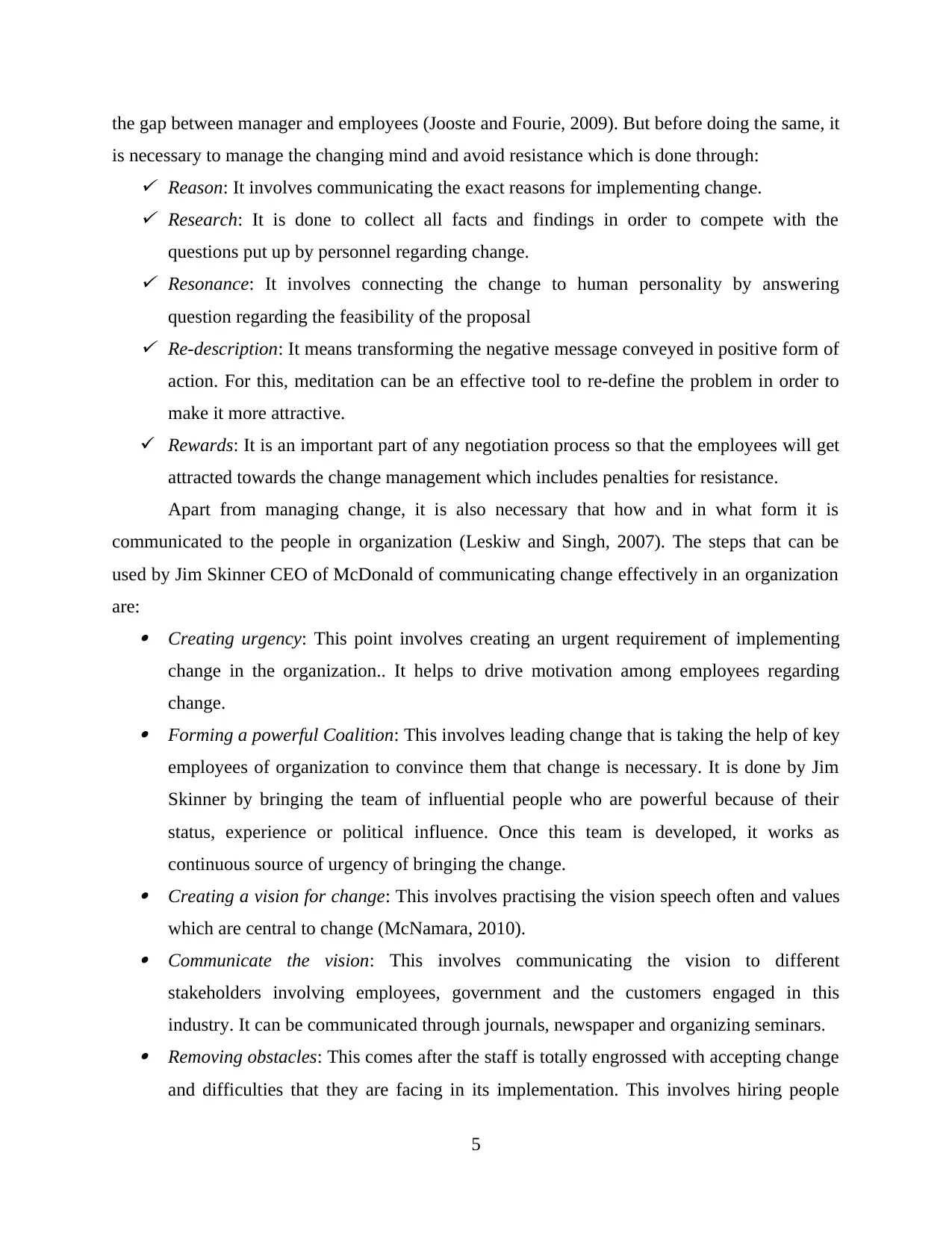
the gap between manager and employees (Jooste and Fourie, 2009). But before doing the same, it
is necessary to manage the changing mind and avoid resistance which is done through: Reason: It involves communicating the exact reasons for implementing change. Research: It is done to collect all facts and findings in order to compete with the
questions put up by personnel regarding change. Resonance: It involves connecting the change to human personality by answering
question regarding the feasibility of the proposal Re-description: It means transforming the negative message conveyed in positive form of
action. For this, meditation can be an effective tool to re-define the problem in order to
make it more attractive.
Rewards: It is an important part of any negotiation process so that the employees will get
attracted towards the change management which includes penalties for resistance.
Apart from managing change, it is also necessary that how and in what form it is
communicated to the people in organization (Leskiw and Singh, 2007). The steps that can be
used by Jim Skinner CEO of McDonald of communicating change effectively in an organization
are: Creating urgency: This point involves creating an urgent requirement of implementing
change in the organization.. It helps to drive motivation among employees regarding
change. Forming a powerful Coalition: This involves leading change that is taking the help of key
employees of organization to convince them that change is necessary. It is done by Jim
Skinner by bringing the team of influential people who are powerful because of their
status, experience or political influence. Once this team is developed, it works as
continuous source of urgency of bringing the change. Creating a vision for change: This involves practising the vision speech often and values
which are central to change (McNamara, 2010). Communicate the vision: This involves communicating the vision to different
stakeholders involving employees, government and the customers engaged in this
industry. It can be communicated through journals, newspaper and organizing seminars. Removing obstacles: This comes after the staff is totally engrossed with accepting change
and difficulties that they are facing in its implementation. This involves hiring people
5
is necessary to manage the changing mind and avoid resistance which is done through: Reason: It involves communicating the exact reasons for implementing change. Research: It is done to collect all facts and findings in order to compete with the
questions put up by personnel regarding change. Resonance: It involves connecting the change to human personality by answering
question regarding the feasibility of the proposal Re-description: It means transforming the negative message conveyed in positive form of
action. For this, meditation can be an effective tool to re-define the problem in order to
make it more attractive.
Rewards: It is an important part of any negotiation process so that the employees will get
attracted towards the change management which includes penalties for resistance.
Apart from managing change, it is also necessary that how and in what form it is
communicated to the people in organization (Leskiw and Singh, 2007). The steps that can be
used by Jim Skinner CEO of McDonald of communicating change effectively in an organization
are: Creating urgency: This point involves creating an urgent requirement of implementing
change in the organization.. It helps to drive motivation among employees regarding
change. Forming a powerful Coalition: This involves leading change that is taking the help of key
employees of organization to convince them that change is necessary. It is done by Jim
Skinner by bringing the team of influential people who are powerful because of their
status, experience or political influence. Once this team is developed, it works as
continuous source of urgency of bringing the change. Creating a vision for change: This involves practising the vision speech often and values
which are central to change (McNamara, 2010). Communicate the vision: This involves communicating the vision to different
stakeholders involving employees, government and the customers engaged in this
industry. It can be communicated through journals, newspaper and organizing seminars. Removing obstacles: This comes after the staff is totally engrossed with accepting change
and difficulties that they are facing in its implementation. This involves hiring people
5
Paraphrase This Document
Need a fresh take? Get an instant paraphrase of this document with our AI Paraphraser
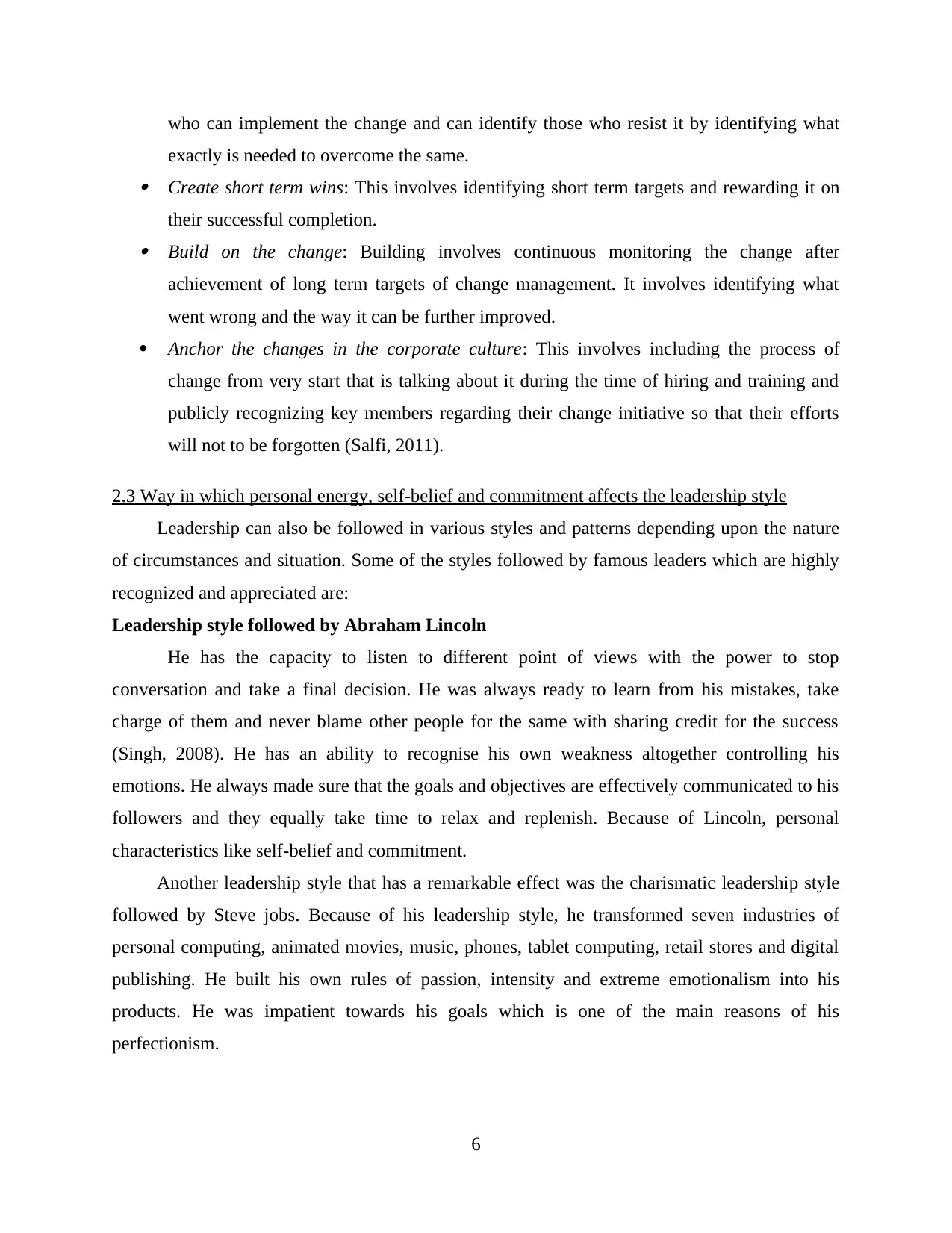
who can implement the change and can identify those who resist it by identifying what
exactly is needed to overcome the same. Create short term wins: This involves identifying short term targets and rewarding it on
their successful completion. Build on the change: Building involves continuous monitoring the change after
achievement of long term targets of change management. It involves identifying what
went wrong and the way it can be further improved.
Anchor the changes in the corporate culture: This involves including the process of
change from very start that is talking about it during the time of hiring and training and
publicly recognizing key members regarding their change initiative so that their efforts
will not to be forgotten (Salfi, 2011).
2.3 Way in which personal energy, self-belief and commitment affects the leadership style
Leadership can also be followed in various styles and patterns depending upon the nature
of circumstances and situation. Some of the styles followed by famous leaders which are highly
recognized and appreciated are:
Leadership style followed by Abraham Lincoln
He has the capacity to listen to different point of views with the power to stop
conversation and take a final decision. He was always ready to learn from his mistakes, take
charge of them and never blame other people for the same with sharing credit for the success
(Singh, 2008). He has an ability to recognise his own weakness altogether controlling his
emotions. He always made sure that the goals and objectives are effectively communicated to his
followers and they equally take time to relax and replenish. Because of Lincoln, personal
characteristics like self-belief and commitment.
Another leadership style that has a remarkable effect was the charismatic leadership style
followed by Steve jobs. Because of his leadership style, he transformed seven industries of
personal computing, animated movies, music, phones, tablet computing, retail stores and digital
publishing. He built his own rules of passion, intensity and extreme emotionalism into his
products. He was impatient towards his goals which is one of the main reasons of his
perfectionism.
6
exactly is needed to overcome the same. Create short term wins: This involves identifying short term targets and rewarding it on
their successful completion. Build on the change: Building involves continuous monitoring the change after
achievement of long term targets of change management. It involves identifying what
went wrong and the way it can be further improved.
Anchor the changes in the corporate culture: This involves including the process of
change from very start that is talking about it during the time of hiring and training and
publicly recognizing key members regarding their change initiative so that their efforts
will not to be forgotten (Salfi, 2011).
2.3 Way in which personal energy, self-belief and commitment affects the leadership style
Leadership can also be followed in various styles and patterns depending upon the nature
of circumstances and situation. Some of the styles followed by famous leaders which are highly
recognized and appreciated are:
Leadership style followed by Abraham Lincoln
He has the capacity to listen to different point of views with the power to stop
conversation and take a final decision. He was always ready to learn from his mistakes, take
charge of them and never blame other people for the same with sharing credit for the success
(Singh, 2008). He has an ability to recognise his own weakness altogether controlling his
emotions. He always made sure that the goals and objectives are effectively communicated to his
followers and they equally take time to relax and replenish. Because of Lincoln, personal
characteristics like self-belief and commitment.
Another leadership style that has a remarkable effect was the charismatic leadership style
followed by Steve jobs. Because of his leadership style, he transformed seven industries of
personal computing, animated movies, music, phones, tablet computing, retail stores and digital
publishing. He built his own rules of passion, intensity and extreme emotionalism into his
products. He was impatient towards his goals which is one of the main reasons of his
perfectionism.
6
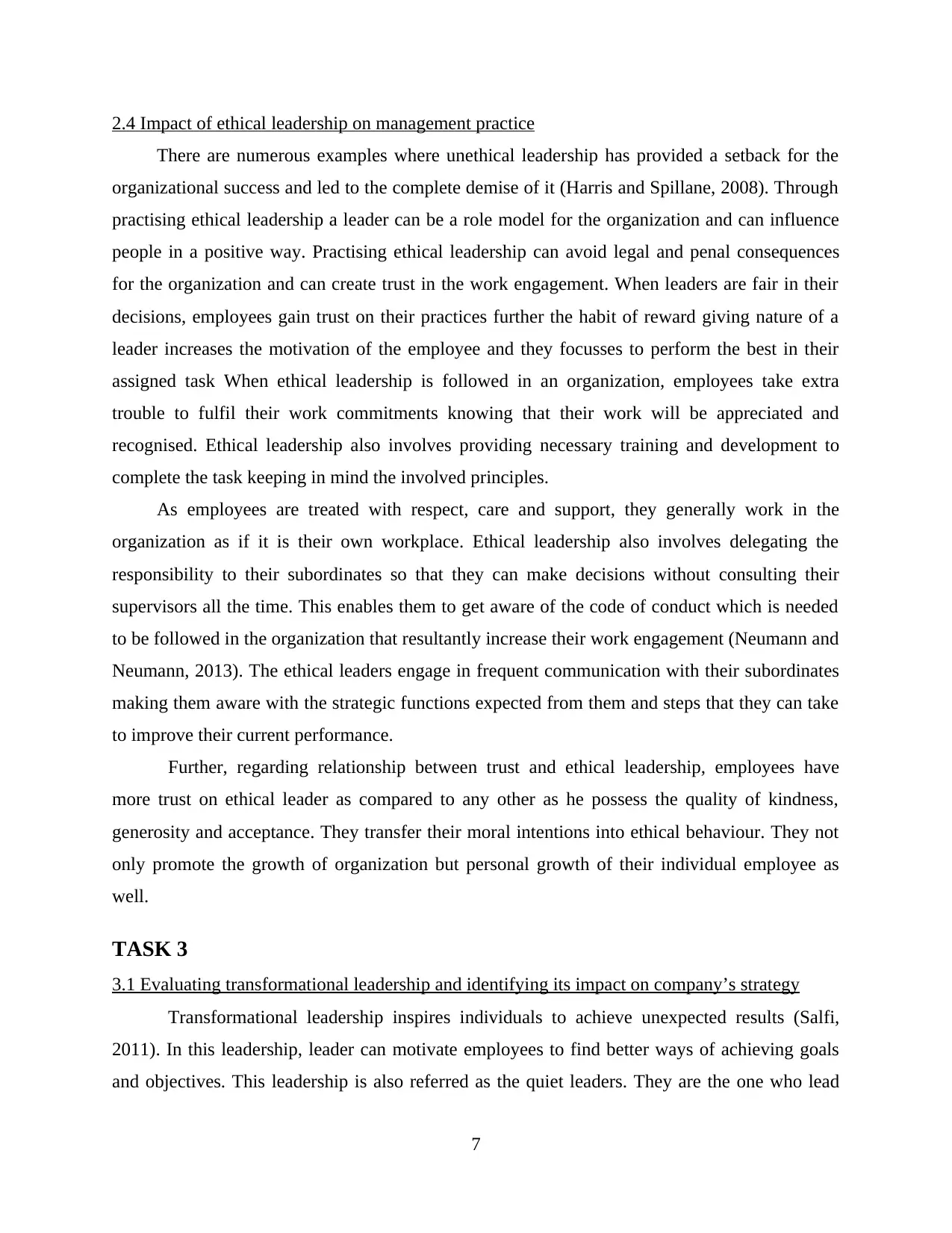
2.4 Impact of ethical leadership on management practice
There are numerous examples where unethical leadership has provided a setback for the
organizational success and led to the complete demise of it (Harris and Spillane, 2008). Through
practising ethical leadership a leader can be a role model for the organization and can influence
people in a positive way. Practising ethical leadership can avoid legal and penal consequences
for the organization and can create trust in the work engagement. When leaders are fair in their
decisions, employees gain trust on their practices further the habit of reward giving nature of a
leader increases the motivation of the employee and they focusses to perform the best in their
assigned task When ethical leadership is followed in an organization, employees take extra
trouble to fulfil their work commitments knowing that their work will be appreciated and
recognised. Ethical leadership also involves providing necessary training and development to
complete the task keeping in mind the involved principles.
As employees are treated with respect, care and support, they generally work in the
organization as if it is their own workplace. Ethical leadership also involves delegating the
responsibility to their subordinates so that they can make decisions without consulting their
supervisors all the time. This enables them to get aware of the code of conduct which is needed
to be followed in the organization that resultantly increase their work engagement (Neumann and
Neumann, 2013). The ethical leaders engage in frequent communication with their subordinates
making them aware with the strategic functions expected from them and steps that they can take
to improve their current performance.
Further, regarding relationship between trust and ethical leadership, employees have
more trust on ethical leader as compared to any other as he possess the quality of kindness,
generosity and acceptance. They transfer their moral intentions into ethical behaviour. They not
only promote the growth of organization but personal growth of their individual employee as
well.
TASK 3
3.1 Evaluating transformational leadership and identifying its impact on company’s strategy
Transformational leadership inspires individuals to achieve unexpected results (Salfi,
2011). In this leadership, leader can motivate employees to find better ways of achieving goals
and objectives. This leadership is also referred as the quiet leaders. They are the one who lead
7
There are numerous examples where unethical leadership has provided a setback for the
organizational success and led to the complete demise of it (Harris and Spillane, 2008). Through
practising ethical leadership a leader can be a role model for the organization and can influence
people in a positive way. Practising ethical leadership can avoid legal and penal consequences
for the organization and can create trust in the work engagement. When leaders are fair in their
decisions, employees gain trust on their practices further the habit of reward giving nature of a
leader increases the motivation of the employee and they focusses to perform the best in their
assigned task When ethical leadership is followed in an organization, employees take extra
trouble to fulfil their work commitments knowing that their work will be appreciated and
recognised. Ethical leadership also involves providing necessary training and development to
complete the task keeping in mind the involved principles.
As employees are treated with respect, care and support, they generally work in the
organization as if it is their own workplace. Ethical leadership also involves delegating the
responsibility to their subordinates so that they can make decisions without consulting their
supervisors all the time. This enables them to get aware of the code of conduct which is needed
to be followed in the organization that resultantly increase their work engagement (Neumann and
Neumann, 2013). The ethical leaders engage in frequent communication with their subordinates
making them aware with the strategic functions expected from them and steps that they can take
to improve their current performance.
Further, regarding relationship between trust and ethical leadership, employees have
more trust on ethical leader as compared to any other as he possess the quality of kindness,
generosity and acceptance. They transfer their moral intentions into ethical behaviour. They not
only promote the growth of organization but personal growth of their individual employee as
well.
TASK 3
3.1 Evaluating transformational leadership and identifying its impact on company’s strategy
Transformational leadership inspires individuals to achieve unexpected results (Salfi,
2011). In this leadership, leader can motivate employees to find better ways of achieving goals
and objectives. This leadership is also referred as the quiet leaders. They are the one who lead
7
⊘ This is a preview!⊘
Do you want full access?
Subscribe today to unlock all pages.

Trusted by 1+ million students worldwide
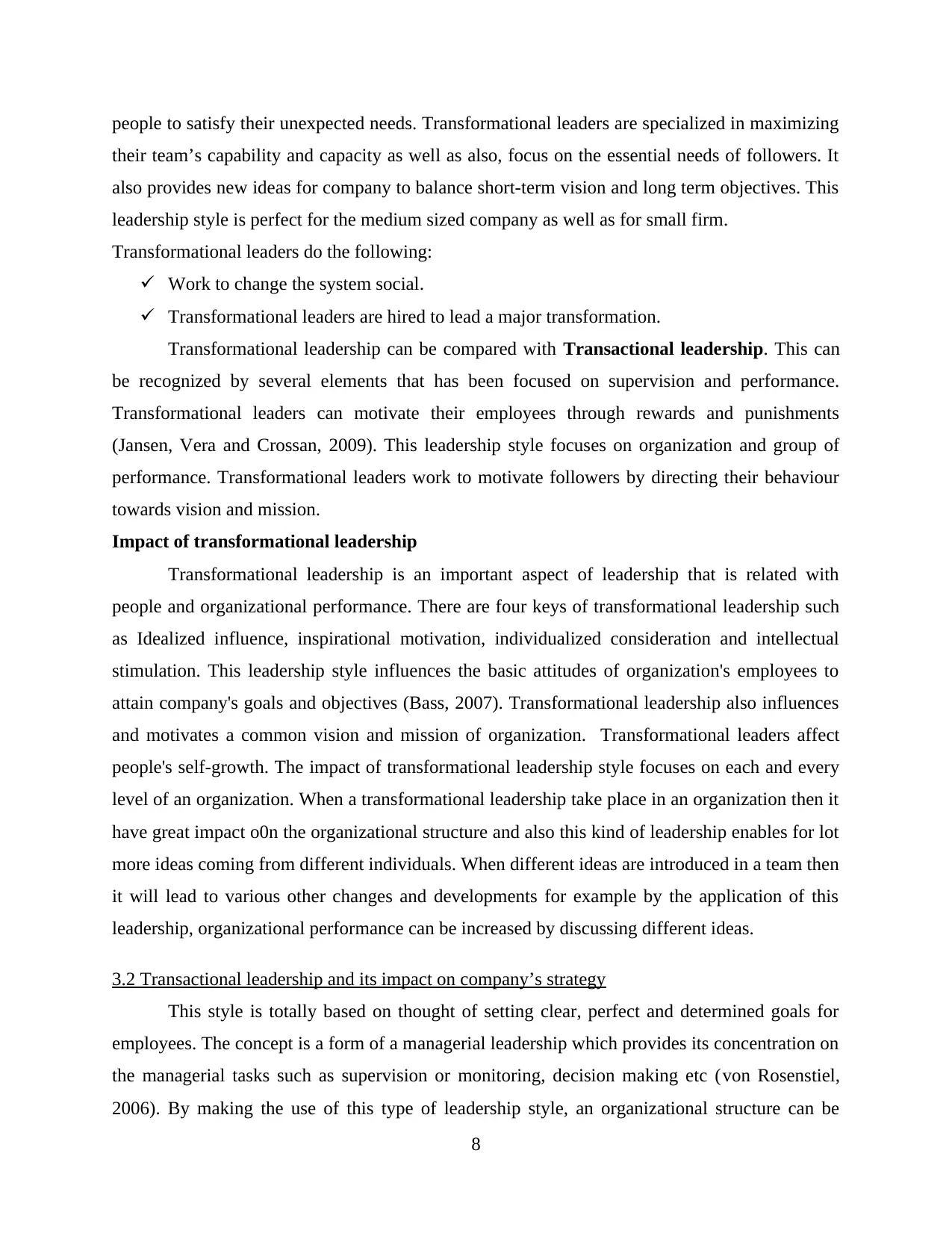
people to satisfy their unexpected needs. Transformational leaders are specialized in maximizing
their team’s capability and capacity as well as also, focus on the essential needs of followers. It
also provides new ideas for company to balance short-term vision and long term objectives. This
leadership style is perfect for the medium sized company as well as for small firm.
Transformational leaders do the following:
Work to change the system social.
Transformational leaders are hired to lead a major transformation.
Transformational leadership can be compared with Transactional leadership. This can
be recognized by several elements that has been focused on supervision and performance.
Transformational leaders can motivate their employees through rewards and punishments
(Jansen, Vera and Crossan, 2009). This leadership style focuses on organization and group of
performance. Transformational leaders work to motivate followers by directing their behaviour
towards vision and mission.
Impact of transformational leadership
Transformational leadership is an important aspect of leadership that is related with
people and organizational performance. There are four keys of transformational leadership such
as Idealized influence, inspirational motivation, individualized consideration and intellectual
stimulation. This leadership style influences the basic attitudes of organization's employees to
attain company's goals and objectives (Bass, 2007). Transformational leadership also influences
and motivates a common vision and mission of organization. Transformational leaders affect
people's self-growth. The impact of transformational leadership style focuses on each and every
level of an organization. When a transformational leadership take place in an organization then it
have great impact o0n the organizational structure and also this kind of leadership enables for lot
more ideas coming from different individuals. When different ideas are introduced in a team then
it will lead to various other changes and developments for example by the application of this
leadership, organizational performance can be increased by discussing different ideas.
3.2 Transactional leadership and its impact on company’s strategy
This style is totally based on thought of setting clear, perfect and determined goals for
employees. The concept is a form of a managerial leadership which provides its concentration on
the managerial tasks such as supervision or monitoring, decision making etc (von Rosenstiel,
2006). By making the use of this type of leadership style, an organizational structure can be
8
their team’s capability and capacity as well as also, focus on the essential needs of followers. It
also provides new ideas for company to balance short-term vision and long term objectives. This
leadership style is perfect for the medium sized company as well as for small firm.
Transformational leaders do the following:
Work to change the system social.
Transformational leaders are hired to lead a major transformation.
Transformational leadership can be compared with Transactional leadership. This can
be recognized by several elements that has been focused on supervision and performance.
Transformational leaders can motivate their employees through rewards and punishments
(Jansen, Vera and Crossan, 2009). This leadership style focuses on organization and group of
performance. Transformational leaders work to motivate followers by directing their behaviour
towards vision and mission.
Impact of transformational leadership
Transformational leadership is an important aspect of leadership that is related with
people and organizational performance. There are four keys of transformational leadership such
as Idealized influence, inspirational motivation, individualized consideration and intellectual
stimulation. This leadership style influences the basic attitudes of organization's employees to
attain company's goals and objectives (Bass, 2007). Transformational leadership also influences
and motivates a common vision and mission of organization. Transformational leaders affect
people's self-growth. The impact of transformational leadership style focuses on each and every
level of an organization. When a transformational leadership take place in an organization then it
have great impact o0n the organizational structure and also this kind of leadership enables for lot
more ideas coming from different individuals. When different ideas are introduced in a team then
it will lead to various other changes and developments for example by the application of this
leadership, organizational performance can be increased by discussing different ideas.
3.2 Transactional leadership and its impact on company’s strategy
This style is totally based on thought of setting clear, perfect and determined goals for
employees. The concept is a form of a managerial leadership which provides its concentration on
the managerial tasks such as supervision or monitoring, decision making etc (von Rosenstiel,
2006). By making the use of this type of leadership style, an organizational structure can be
8
Paraphrase This Document
Need a fresh take? Get an instant paraphrase of this document with our AI Paraphraser
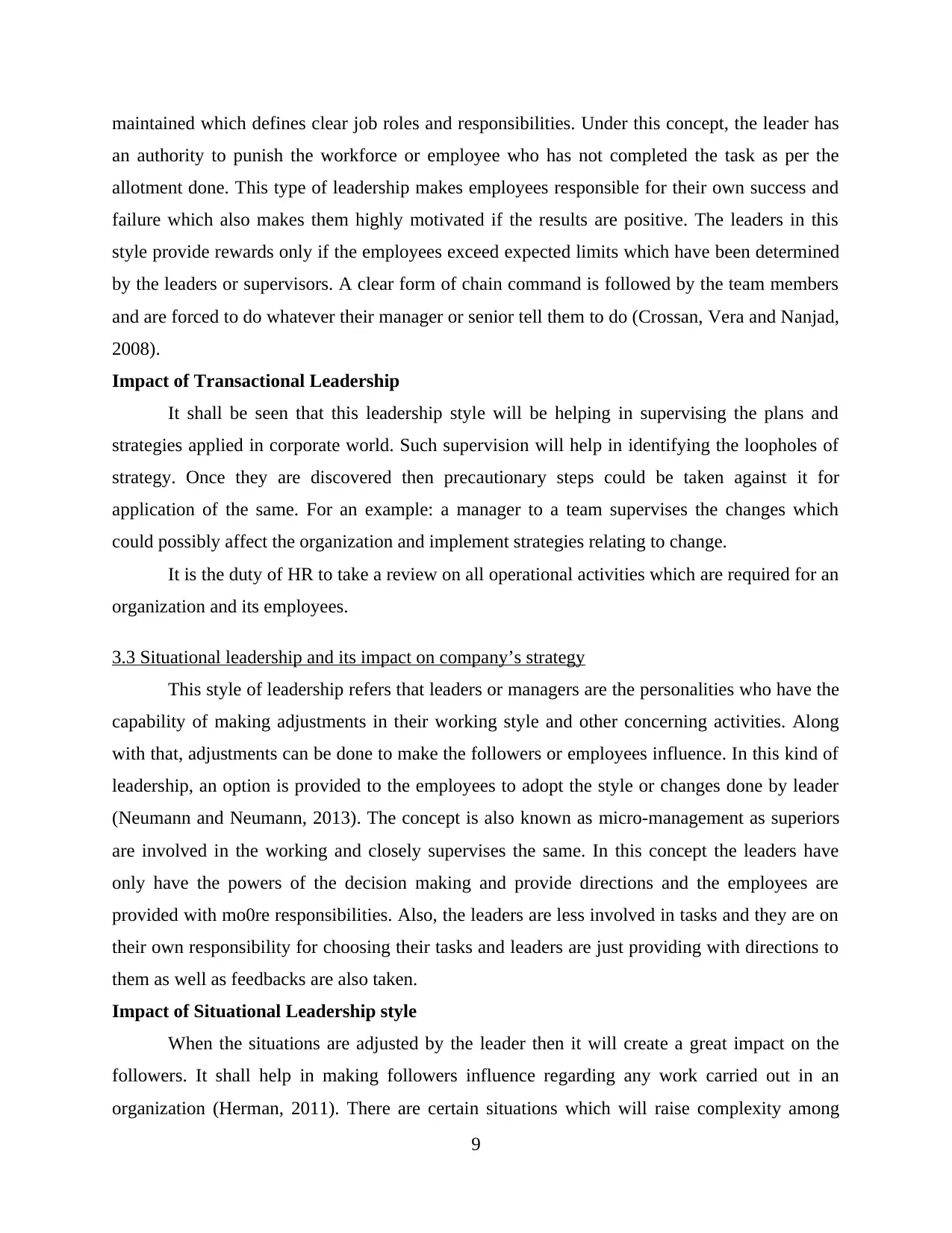
maintained which defines clear job roles and responsibilities. Under this concept, the leader has
an authority to punish the workforce or employee who has not completed the task as per the
allotment done. This type of leadership makes employees responsible for their own success and
failure which also makes them highly motivated if the results are positive. The leaders in this
style provide rewards only if the employees exceed expected limits which have been determined
by the leaders or supervisors. A clear form of chain command is followed by the team members
and are forced to do whatever their manager or senior tell them to do (Crossan, Vera and Nanjad,
2008).
Impact of Transactional Leadership
It shall be seen that this leadership style will be helping in supervising the plans and
strategies applied in corporate world. Such supervision will help in identifying the loopholes of
strategy. Once they are discovered then precautionary steps could be taken against it for
application of the same. For an example: a manager to a team supervises the changes which
could possibly affect the organization and implement strategies relating to change.
It is the duty of HR to take a review on all operational activities which are required for an
organization and its employees.
3.3 Situational leadership and its impact on company’s strategy
This style of leadership refers that leaders or managers are the personalities who have the
capability of making adjustments in their working style and other concerning activities. Along
with that, adjustments can be done to make the followers or employees influence. In this kind of
leadership, an option is provided to the employees to adopt the style or changes done by leader
(Neumann and Neumann, 2013). The concept is also known as micro-management as superiors
are involved in the working and closely supervises the same. In this concept the leaders have
only have the powers of the decision making and provide directions and the employees are
provided with mo0re responsibilities. Also, the leaders are less involved in tasks and they are on
their own responsibility for choosing their tasks and leaders are just providing with directions to
them as well as feedbacks are also taken.
Impact of Situational Leadership style
When the situations are adjusted by the leader then it will create a great impact on the
followers. It shall help in making followers influence regarding any work carried out in an
organization (Herman, 2011). There are certain situations which will raise complexity among
9
an authority to punish the workforce or employee who has not completed the task as per the
allotment done. This type of leadership makes employees responsible for their own success and
failure which also makes them highly motivated if the results are positive. The leaders in this
style provide rewards only if the employees exceed expected limits which have been determined
by the leaders or supervisors. A clear form of chain command is followed by the team members
and are forced to do whatever their manager or senior tell them to do (Crossan, Vera and Nanjad,
2008).
Impact of Transactional Leadership
It shall be seen that this leadership style will be helping in supervising the plans and
strategies applied in corporate world. Such supervision will help in identifying the loopholes of
strategy. Once they are discovered then precautionary steps could be taken against it for
application of the same. For an example: a manager to a team supervises the changes which
could possibly affect the organization and implement strategies relating to change.
It is the duty of HR to take a review on all operational activities which are required for an
organization and its employees.
3.3 Situational leadership and its impact on company’s strategy
This style of leadership refers that leaders or managers are the personalities who have the
capability of making adjustments in their working style and other concerning activities. Along
with that, adjustments can be done to make the followers or employees influence. In this kind of
leadership, an option is provided to the employees to adopt the style or changes done by leader
(Neumann and Neumann, 2013). The concept is also known as micro-management as superiors
are involved in the working and closely supervises the same. In this concept the leaders have
only have the powers of the decision making and provide directions and the employees are
provided with mo0re responsibilities. Also, the leaders are less involved in tasks and they are on
their own responsibility for choosing their tasks and leaders are just providing with directions to
them as well as feedbacks are also taken.
Impact of Situational Leadership style
When the situations are adjusted by the leader then it will create a great impact on the
followers. It shall help in making followers influence regarding any work carried out in an
organization (Herman, 2011). There are certain situations which will raise complexity among
9

employees and by the application of situational leadership, such complexity can be reduced with
application of making several adjustments in the work. This leadership helps in removing
complex barriers in company.
CONCLUSION
From the above carried out analysis, it has been concluded that the concept of managers
as an effective leader and leader as an effective manager has been analysed. Further the balance
the demand and the strategic management and the strategic leadership. Moreover the evaluation
of the transformational, situational, transactional and situational leadership and also the impacts
of the same on the company strategy has been explained. Further the evaluation of the
transformational leadership has been done and its impacts on the corporate strategy has been
done.
10
application of making several adjustments in the work. This leadership helps in removing
complex barriers in company.
CONCLUSION
From the above carried out analysis, it has been concluded that the concept of managers
as an effective leader and leader as an effective manager has been analysed. Further the balance
the demand and the strategic management and the strategic leadership. Moreover the evaluation
of the transformational, situational, transactional and situational leadership and also the impacts
of the same on the company strategy has been explained. Further the evaluation of the
transformational leadership has been done and its impacts on the corporate strategy has been
done.
10
⊘ This is a preview!⊘
Do you want full access?
Subscribe today to unlock all pages.

Trusted by 1+ million students worldwide
1 out of 15
Related Documents
Your All-in-One AI-Powered Toolkit for Academic Success.
+13062052269
info@desklib.com
Available 24*7 on WhatsApp / Email
![[object Object]](/_next/static/media/star-bottom.7253800d.svg)
Unlock your academic potential
Copyright © 2020–2025 A2Z Services. All Rights Reserved. Developed and managed by ZUCOL.





